THE MILL CONTRACT OF 1837
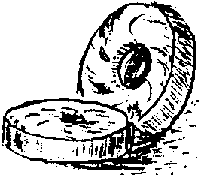
About 1595 the village of Brettach decided to tear down the old run-down mill
and on the same spot erect a new, larger, good-looking buildind.
The times were favourable and, as can be seen from a brief notice in a report of that time,
there was no difficulty getting permission.
It so happens that the 3 most significant buildings in Brettach in the 19th
centary, namely the Chanofsky Castle, the Lamm (Guesthouse), and the Mill were all
build about 1600. Maybe the same builder was involved as all 3 buildings give
evidence of similarity.
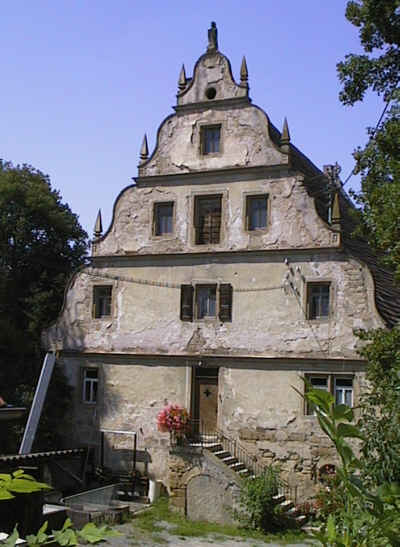
Work on the new mill began in 1600. The old building probably had a stone
foundation on witch the framework was placed. The new mill was large and
build of stone; the facade, and above all else, the gable was hewn in renaissance
ornamentation out of Brettach sandstone.
The curved of the south-east gable have obelisks and right on top, above
the typical renaissance shell, stands a lion holding a stone slab.
On the top of the north-west gable sits a stone millwheel. The round arch
of the entrance to the mill room is surrounded with renaissance ornamental sandstone.
At the weir of the Brettach stream a new canal was made and the water drove
3 below-ground mill wheels.
Only in recent times were 2 of the millwheels
removed, and the remaining large waterwheel served the mill till 1962 together
with 2 direct-current generators, witch later were replaced with a turbine.
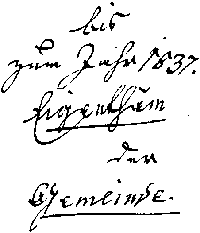
The Brettach village mill was owned by the village for 235 years - till 1837.
In that year it was sold to Georg Nikolaus Simpfendörfer (1792 - 1864),
"local citizen and councillor", for 8100 guilders.
Many stories concerning the sale circulated in Brettach.
An example:
at the sale many Brettachers were surprised that "d'r Niklas"
was the buyer. "Where will he get all that money?" many asked.
Georg Nikolaus Simpfendörfer lived with his wife (1782 - 1805 ),
a Schumacher widow, nee Eberlen, and his daughters in simple circumstances.
At the mill sale Nikolaus was silent, but went home smiling in order to get
a big fat sock filled with the money for the purchase of the mill.
The Brettachers were astounded and shook their heads and debated for a long
time as to where Nikolaus Simpfendörfer got all this money. Envy was
certainly a motive for the many and various rumours and superstituous stories
whitch made their rounds.
None of this affected the new owner. With diligence and carfulness
he successfully ran the mill, as 20 years later, in 1875, the writer
Franz Häfelin reported: "Simpfendörfer
is still the owner/manager of the mill and enjoys a good income".
That Nikolaus Simpfendörfer was truly realistic but also sly is indicated
by the folk myth concerning him: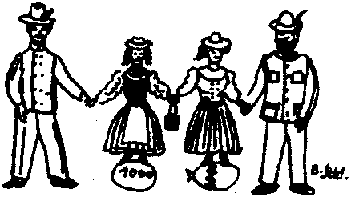
When both his daughters cam to marriageable age he was once teased about their
smallness. He simply laughed and said, "When I put them on a pile of money
they are just as tall as other girls."
In 1806 his daughter Louise Christiane married the tanner Christian Ludwig Herrmann
from Cleversulzbach. In the following generationes the mill was managed by the sons
Carl Ludwig (1852 - 1922), Carl Gustav ( 1887 - 1960) and Carl Friedrich
(1912-1977). The inheritors continued the tradition of the village. Duty and
responsibility for the village was just important as milling and farming. Out
of their various interests, only the commitment of the youngest of the "Carl Herrmanners"
is mentioned, namely, his concern for purity of air. He was concerned that in our
region no oil refinery be build. And that was a time when hardly anyone was concerned
about pollution. This position was naturally also because of another deeply rooted
reason in the family: All millers wanted to uphold the rural farming structures.
From the local history:
"1600 was the year in witch building the present mill was started."
"1602 was the year in witch the mill was completed. Building costs amounted to 2 776 guilders."
The contract gives some insights in to how, in earlier times, a mill was run.
Later changes are here not taken into consideration.
The entire property and buildings with all rights, privileges and responsibility are
handed over the buyer.
Payment to be made as follows: 1/3(cash) when sale is ratified; balance to be paid from
1 July 1837 in 3 annual installments - on 1 July 1838, 1839 and 1840. These 3 dates must
be kept unless otherwise determined by the council.
It is the buyers responsibility to pay taxes and other duties, guilters, interest,
trade tax and the like from 1 July 1838.
.... owner's rights ...
The buyer and future owners of the mill shall make their claims for building timber,
firewood and necessary fuel only from the village council.
The buyer and future owners of the mill have the responsibility in winter to heat
the floor room for the customer.
Should the duty of citizens to support the mill fail on the day of sale ratification,
the council reserves the right, sooner or later, to resume control of the mill.
Miller's payment: the right, without exeption, to take from all raw seed such as
wheat, corn etc, 1/16th, or 16 simre; likewise he has the right from all the wheat
brought for milling 1/16th, wheter for milling or not. From all flat grains, except
wheat, whitch are brought to the mill but not milled or crushed, such as rye, corn,
barley, oats, field beans and the like, he may take 1/2, i.e. a 32nd part. This rule
onlyapplies to those who live here. The handling of outsiders payments is left to the
miller who, for his own sake, in order to retain his customers, should not take too much.
The left-over bits from milling like hay and bran remain the property of the supplier;
the miller can make no claim.
The council retains the right to conduct the annual sheep swim in the mill pond
from the weir to the mill, and that for now, and in the future, becomes the
responsibility of the miller, with costs paid by council, to clean the pond of slime,
and also to clear the area between the weir and the stream for the sheep to be herded.
Not now or in the future ca he make a claim for compensation to the council. The said
path is included in the contract from the date of sale.
The mill equipment .... is included in the sale.
The council would like to see the buyer, without damaging the mill equipment, to
install other works, e.g. a hemp, oil, gypsum or wood mills. But the mill has to
remain a flour mill, and the buyer is obliged to maintain and promote 3 flour outlets
along side the grinders.
The buyer shall, at his own costs, keep the whole masonry above and below the mill
in good repair.
The council at any future sale retains first right of purchase.
The buyer does not need to own a cart since the customers bring their own grain
to the mill.
The top part of the stall building, including the attic, belongs to the council, but
is used by the school teacher, and will be maintained by the council ...
The mill area with its additions are precisely marked out.
The mill owner must give priority to the care and welfare of local citizens. There
are strict regulations for milling when the grain is brought of the mill. Penalties
cannot be laid against present or future customers. He must strictly abide by the
current rules of the mill.
The buyer is responsible for the entire purchase costs. He alone has to pay the
tax of them.
No changes can be made to this contract once it has been ratified by degree of the
Royal authorities of the Neckar District on 4 July 1837, and also after the official
decisions of council on 29 April 1837.
The village of Brettach, by public auction, decided on 29 April 1837, and ratified by
regional imperial decree on 4 July 1837, sells to Nikolaus Simpfendörfer, local
citizen and farmer.
Building
One flour mill, built entirely of stone, with 4 fine crushers and 1 rough crusher;
with a small stall included at the Brettach stream lower in the village.
Annually there must by paid to the finance office:
Money - 2 guilders, 2 kreuzers, 2 groschen
Old hens - 2
Young hens - 24
Plus rye, 1 bushell 5 simre (wooden measuring device for grain)
Later: 1 garden plot behind the mill, next to the mill canal and the Brettach stream;
from above the ewir to below the village-owned mill meadow (Mühlwiese).
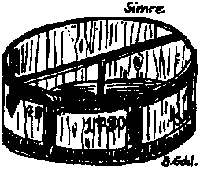 (In what follows the adjoining buildings are described. Lengh is cescribed as shoe(schuh),
and heigh as evening(abend) and morning(morgen)).
(In what follows the adjoining buildings are described. Lengh is cescribed as shoe(schuh),
and heigh as evening(abend) and morning(morgen)).
The wooden section of the original stall building and the entire attic belongs to the
school. (The old Brettach school, before the destruction of 1945, stood where the
kindergarten now stands. The school and teacher had the right to store their firewood
in the attic of the small stall building at the mill).
SALE CONTRACT of the flour mill amounts to 8100 guilders on the following conditions:
Georg Nikolaus Simpfendörfer
A.W.Herrmann
Hochstetter
Kuttruff
Simpfendörfer
Kuttruff
Simpfendörfer
Ehmann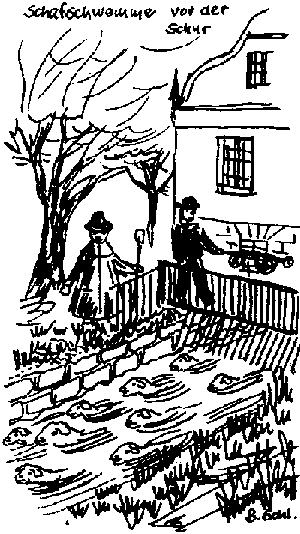
aus "Rückblicke" des Heimatgeschichtlichen
Vereins, Langenbrettach e.V. [Nr. 13/14]
Verfasser: Herbert Schlegel, Kurt Simpfendörfer, Wolfgang Gebhard
Zeichnungen: Barbara Schlegel
(Translator: S. M. Simpfendorfer)